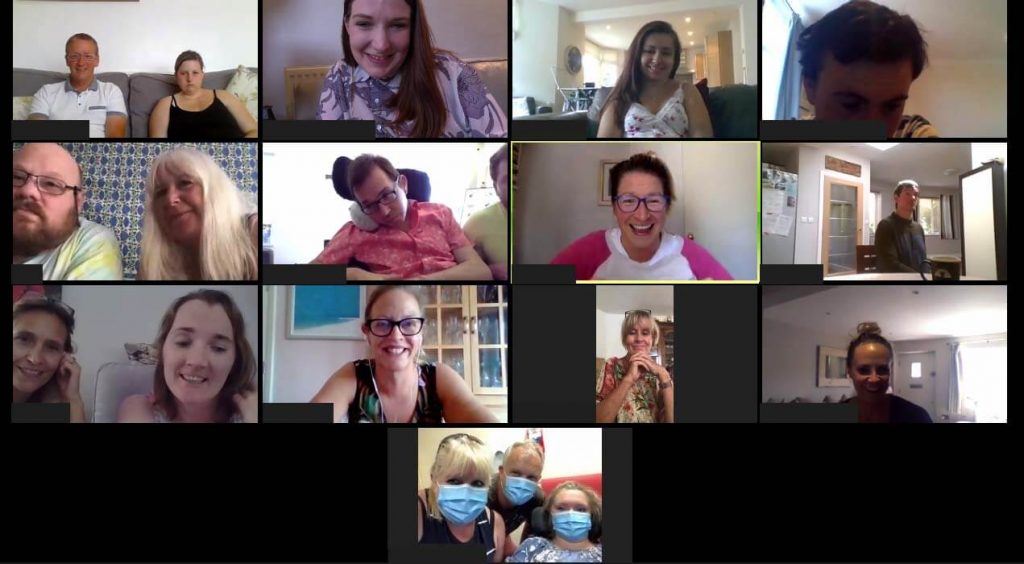Can everyone dial in? – The challenges and benefits of video conferencing for those living with a brain injury

Whilst the first weeks of lockdown showed the many creative ways people were getting involved in video conferencing, as time has gone on we are starting to hear more stories about the stresses that video calling can bring into people’s lives.
Video calling has been called a blessing and a curse, a potential game-changer for equality in the workplace, and unfortunately even a drain on people’s energy, so how does it affect people who already struggle with cognitive issues, such as someone with a brain injury?
The difficulties of video calling with a brain injury
People who are living with a brain injury can experience a wide range of problems, not least fatigue, issues with concentration, and even visual impairments. Therefore something like a video call can present significant challenges.
We spoke to specialist brain injury counsellor Diane Aronson about her experience using video conferencing with clients.
For her, anxiety is a key issue that she frequently notices. “I often find that I need to reassure people that things could go wrong with the technology and that, if they do, there’s no need to panic”, Diane said. “The uncertain times we are living in, with no route out at the moment, is of course exacerbating this. Although, in opposition to this, everything coming to a halt has lifted the pressure on some individuals to achieve rehab goals, and has actually helped to relieve some of the stress”.
Anger issues also become slightly more difficult to manage over video call. “Many individuals with traumatic brain injury experience problems with anger, and when on a video call we just need to remain mindful of this”, Diane said. “It is important to have strategies in place to deal with any issues that might arise during a session”.
Furthermore, processing skills are impaired in those with a brain injury, and Diane explained that during the sessions there “may be lags while the interviewee takes time to process what’s been said and catch up”.
Tips if you are having to conduct video calls with people who have a brain injury
When looking at how to manage video calls with brain injured individuals, Diane has broken things down into the following tips:
- For your first video call, ensure there is an enabler or companion on hand to assist with set up
- Confidential issues are usually discussed, so try to find appropriate surroundings to conduct the call
- Keep sessions shorter than you would if you were meeting face-to-face, as it is easier for the individual to lose the high level of concentration required for a video call
- To help with the individual’s concentration, break up the call into sessions. E.g. you could use a screen share to show pictures or materials that will be of help
- Consider switching off the screen showing the brain-injured individual’s face, as it can be distracting - and often isn’t really necessary!
- For someone who has visual impairments, suggest they link up to a smart TV for the call - there are some helpful suggestions for how to do this here
- You can activate closed captions (subtitles) on the call if your client is hard of hearing
- Consider minimising the need to use keyboards, as this can add an element of multi-tasking which may break the concentration of TBI sufferers.
The good video conferencing can bring to those with a brain injury
Video calling doesn’t just add difficulty to brain injured individual’s lives though. Diane has noted that couple’s work has proved very successful, and has even heard anecdotal evidence of separated individuals getting back together during lockdown.
The technology can also be very beneficial for those who feel isolated. “Being able to connect ‘socially’ is very important for many, as part of acceptance and commitment therapy”, Diane said. “When threatened, mammals connect with each other and become tribal and yet we are being told to isolate ourselves. During this time video conferencing can provide a sense of soothing and connection”.
Another person who has positive experiences of video conferencing with brain injured individuals is Nicola Cale, a case manager at CCMS. We spoke to her about what she has experienced.
“As coordinator of the Oxford Silverlining [a charity offering support to people with a brain injury and their families], I have been hosting virtual meetings to replace the ones which would otherwise take place at RWK Goodman’s offices”, she said. “This has had an immediate added benefit, in that the monthly meeting has been combined with the group from Bristol’s gathering; expanding the network of attendees who are geographically far apart and giving them that vital opportunity to connect during lockdown.”
“Make it fun” – managing regular virtual meetings
Nicola has taken the opportunity to get creative with video conferencing, too. She was keen to tell us that the Silverlining has “a weekly art group by video which has been going well. The attendance has been extensive, and we have welcomed people from further afield who would not normally come.” Furthermore, she said, “CCMS have been offering bingo, a weekly disco, and a weekly quiz – all set at an appropriate level and encouraging interactivity amongst the attendees”.
To Nicola, the technology has given the individuals she works with a real opportunity to connect at a time when they might not otherwise have been able to. “I’ve witnessed, and continue to witness, a great deal of encouragement and support between the Silverlining members. Their shared experience has brought them together despite the ‘virtual’ aspect of the meetings now”, she said. “In fact, some have spoken about how their experience has given them the resources to cope with this lockdown, as being in recovery from brain injury is not dissimilar: they were stuck indoors, whether that was at home or in hospital, and unable to move.”
It can be a challenge sometimes, but no more than with any other meeting, Nicola said. “Managing a large-ish group is not too different to the large groups at the office. You have to make sure to include everyone and balance all the ‘air time’ for all”. She suggested time management is a key factor in her success; “we were on for an hour and a half the other day, but try to keep it to an hour – it’s important to be flexible and allow people to leave early or arrive late”.
Don’t get too serious about managing the meeting though, she said. “Try to make it fun. It’s important to do this and link conversations so that people can work on their cognitive skills.”
[caption id="attachment_56088" align="aligncenter" width="640"] Nicola Cale (second row, third column from left) leads a Silverlining charity conference call[/caption]
Nicola Cale (second row, third column from left) leads a Silverlining charity conference call[/caption]
So video conferencing, whilst it can be a challenge for those who are living with a brain injury, can be an important way to connect with those around them and with those who have experienced the same things they have. Through effective management, using the technology can even be a great deal of fun.
Most importantly, as Nicola has come to realise during the lockdown, “it lets people know they matter”.